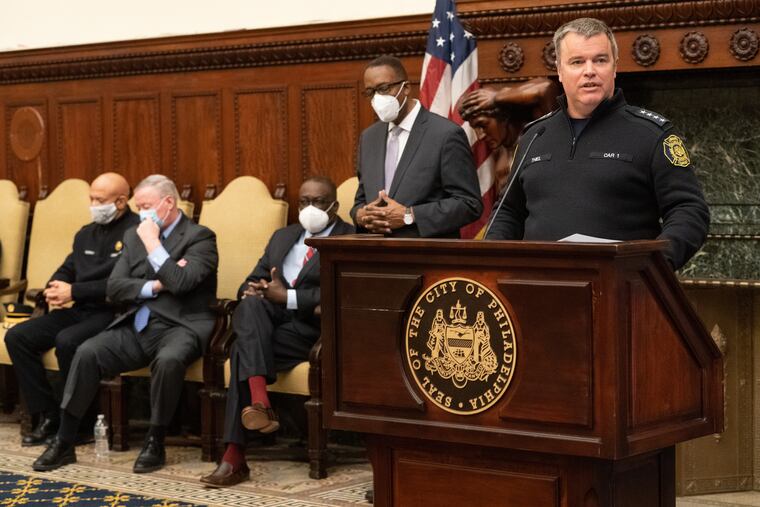What a firefighter taught a neurosurgeon about handling traumatic stress
A few months ago, Fire Commissioner Adam Thiel committed a remarkable act of leadership. It didn’t make news, but I noticed it on his Twitter feed.

A few months ago, Philadelphia Fire Commissioner Adam Thiel committed a remarkable act of leadership. It didn’t make news, but I noticed it on his Twitter feed. He personally visited the crews who responded to the devastating Fairmount fire in a process called critical incident stress debriefing, or CISD.
The fire destroyed lives, and also was hard for the first responders who worked the catastrophe. What they experienced is called secondary post-traumatic stress, the stress of closely witnessing the tragedies of other people.
I learned about CISD from the commissioner a few years ago when I was in the throes of processing my own critical incident — a medical procedure that went wrong for reasons I did not understand. He kindly agreed to meet me and describe the first-responder community’s tools for processing events such as the Fairmount fire.
The nation’s four million nurses and one million doctors do not have these tools to use after a devastating medical incident. All we have now is a process called morbidity and mortality, in which we review bad things that happen to patients. M&M identifies process holes and assesses whether there were errors made by any individuals involved in a case. It’s investigative, not therapeutic.
I’d passed the scrutiny of my peers. I hadn’t made a mistake, but there is no absolution in M&M. I rehashed the case in my head over and over again that summer, listening to way too much Sarah McLachlan. It cost me sleep and good health, and I felt less effective than I should have been for my other patients. I was a zombie.
I scribbled fiercely as he spoke. While there isn’t a tidy solution to pack up these human reactions and ship them off, they are a 100% normal response to abnormal events. He asked whether it woke me up at night. Of course it did. “That’s it. That’s secondary post-traumatic stress,” he said. “It’s not even a disease or a disorder. It’s normal.” He told me about his own wake-up event.
Two middle-aged guys in a government office, a leading firefighter and a neurosurgeon, drinking coffee from Styrofoam cups, and that’s how my healing began.
In his memoir Do No Harm, English neurosurgeon Henry Marsh quotes René Leriche, an early-20th-century vascular surgeon: “Every surgeon within himself carries a small cemetery, where from time to time he goes to pray — a place of bitterness and regret, where he must look for an explanation for his failures.” So awfully Victorian. That doesn’t sound too healthy, does it? But that is medical culture.
Recently, Harvard otolaryngologist Jo Shapiro gave a talk on peer support for physicians after adverse events. She pointed out that 88% of physicians would like to talk to a peer, 48% wanted a mental health professional, and 29% would contact an employee assistance program. Although CISD is a formal process, oftentimes informal support can move us through grief — that’s what it is — but we don’t initiate.
Bottling up because we’re strong and stern and taciturn can lead to a lot of maladaptive behavior — substance abuse, domestic violence and more. Suicide rates are more than 40% higher than baseline among nurses and first responders and twice baseline among physicians. Surely, we can do better than a cemetery of bitterness and regret. It could be CISD or maybe a buddy system, as in the armed forces — wingman, shipmate, battle buddy — or something else altogether, such as a policy initiative.
» READ MORE: Neurosurgeon discovers pandemic baking and medicine aren't so far apart.
In mid-March, President Joe Biden signed the Dr. Lorna Breen Health Care Provider Protection Act, providing mental health funding for health-care workers. It’s a start and I’m grateful for that.
I was fortunate to have a saint of a social worker in our department do some ad hoc talk therapy with me, and I leaned on a neurosurgeon friend to unpack it. They were essential, but reaching out to them was essential, too, and scary.
Everyone who takes care of patients has seen something we’d like to have turned out differently, but we all continue to do the work because the restorative potential is amazing. A Catholic priest explained to me that it’s a privilege to be witness to that, to be present in guiding patients and their families. Even when “restorative” is not on the menu, helping patients and families end well is good.
A seasoned nurse practitioner, new to neurosurgery, came to me about a year ago. She witnessed a patient die and felt responsible, wondering whether she could have done something different. I admired her courage for wanting to discuss it. Wouldn’t it be better, though, if that were just normal?
“I’m going to tell you a story,” I began.
Thank you, Commissioner Thiel.
Patrick Connolly is Penn Medicine clinician and neurosurgery chief at Virtua Health. The opinions expressed in this article do not represent those of the University of Pennsylvania Health System or the Perelman School of Medicine.